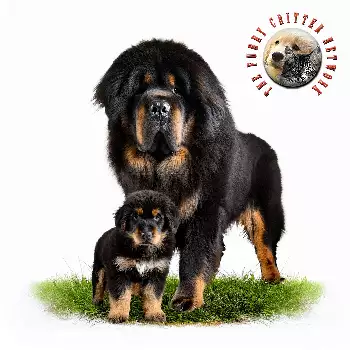The Do-Khyi typically lives ten to twelve years, which represents a reasonable lifespan for a giant breed dog. Like all large and giant breeds, Tibetan Mastiffs face certain health concerns that responsible owners should understand and monitor throughout the dog's life. Genetic predispositions to specific conditions affect the breed, though not all individuals will develop these problems. Awareness enables early detection and intervention, often significantly improving outcomes.
Hip dysplasia represents one of the most common orthopedic concerns in the breed, occurring when the hip joint develops abnormally and potentially leading to arthritis and pain. This hereditary condition varies in severity from mild changes visible on X-rays but causing no symptoms to severe dysplasia causing lameness and disability. Responsible breeders screen breeding stock through Orthopedic Foundation for Animals or PennHIP evaluations to reduce incidence in offspring. Maintaining ideal body weight throughout the dog's life reduces stress on joints and may slow progression in affected individuals.
Elbow dysplasia, another orthopedic condition affecting the elbow joint, can cause lameness and arthritis. Like hip dysplasia, this condition has genetic components, and responsible breeding programs include elbow screening. Early diagnosis through X-rays allows for treatment options including medication, weight management, physical therapy, or surgical intervention depending on severity.
Hypothyroidism occurs in Tibetan Mastiffs, causing symptoms including weight gain, lethargy, skin problems, and coat changes. Blood testing diagnoses this condition, which responds well to daily thyroid hormone supplementation. Regular veterinary examinations including routine blood work can detect thyroid dysfunction before obvious symptoms appear, allowing for early treatment that prevents associated complications.
Inherited demyelinative neuropathy, a serious neurological condition, has been identified in Tibetan Mastiffs. This hereditary disease affects the nervous system and typically manifests in puppies between six and twelve weeks of age. Genetic testing identifies carriers, allowing responsible breeders to make informed breeding decisions that prevent production of affected puppies. Breeders should test breeding stock and provide results to puppy buyers.
Eye conditions including progressive retinal atrophy and cataracts can affect the breed. Progressive retinal atrophy is a hereditary condition causing gradual vision loss leading to blindness. Annual eye examinations by veterinary ophthalmologists certified by the Canine Eye Registry Foundation help detect eye problems early. Responsible breeders screen breeding stock and provide CERF certifications to puppy buyers.
Bloat, or gastric dilatation volvulus, represents a life-threatening emergency condition affecting deep-chested dogs. The stomach fills with gas and may twist, cutting off blood supply and causing rapid deterioration. Symptoms include restlessness, attempts to vomit without producing anything, and abdominal distension. Immediate veterinary intervention is critical. Feeding multiple small meals rather than one large meal, avoiding exercise immediately after eating, and using elevated feeding bowls may reduce risk, though preventive measures are not completely effective. Some owners elect prophylactic gastropexy surgery, particularly when dogs are spayed or neutered.
Preventive care forms the foundation of health maintenance for Do-Khyi dogs. Regular veterinary examinations, typically twice yearly, allow for early detection of health problems through physical examination and routine blood work. Vaccinations appropriate for the dog's lifestyle and risk factors protect against infectious diseases. Parasite prevention including heartworm prophylaxis and flea and tick control safeguards health year-round. Maintaining ideal body weight through appropriate feeding and regular exercise prevents obesity, which contributes to joint problems, heart disease, and shortened lifespan. Genetic health screening of all breeding stock reduces the incidence of hereditary conditions in future generations, promoting overall breed health and longevity.
Common Health Issues
- Hip dysplasia represents one of the most common orthopedic concerns in the breed, occurring when the hip joint develops abnormally and potentially leading to arthritis and pain.
- Like hip dysplasia, this condition has genetic components, and responsible breeding programs include elbow screening.
- Hypothyroidism occurs in Tibetan Mastiffs, causing symptoms including weight gain, lethargy, skin problems, and coat changes.
- Annual eye examinations by veterinary ophthalmologists certified by the Canine Eye Registry Foundation help detect eye problems early.
- Maintaining ideal body weight through appropriate feeding and regular exercise prevents obesity, which contributes to joint problems, heart disease, and shortened lifespan.
Preventive Care & Health Monitoring
- Like hip dysplasia, this condition has genetic components, and responsible breeding programs include elbow screening.
- Early diagnosis through X-rays allows for treatment options including medication, weight management, physical therapy, or surgical intervention depending on severity.
- Regular veterinary examinations including routine blood work can detect thyroid dysfunction before obvious symptoms appear, allowing for early treatment that prevents associated complications.
- Feeding multiple small meals rather than one large meal, avoiding exercise immediately after eating, and using elevated feeding bowls may reduce risk, though preventive measures are not completely effective.
Regular veterinary check-ups and preventive care are essential for maintaining your Do-Khyi's health and longevity.

